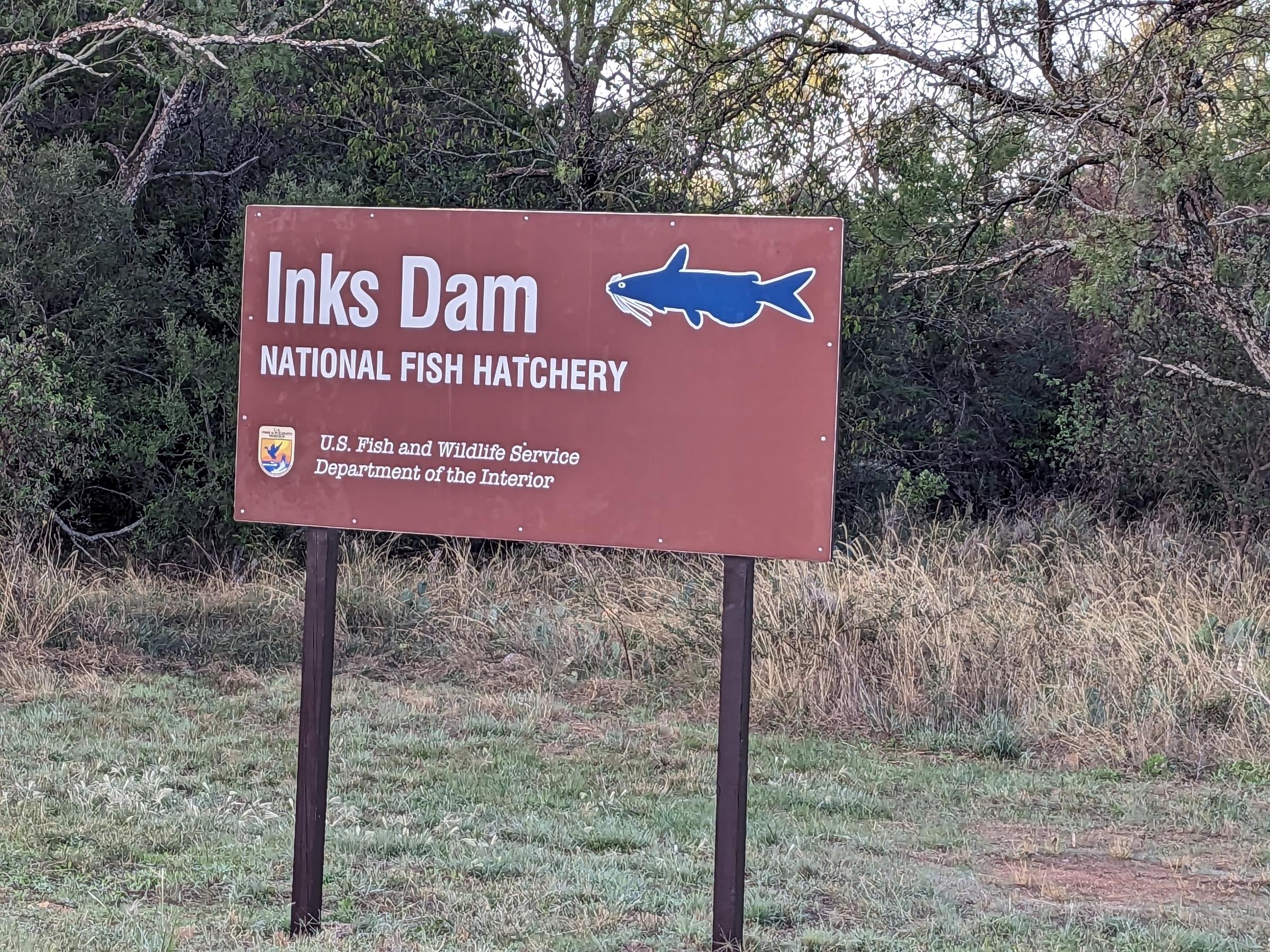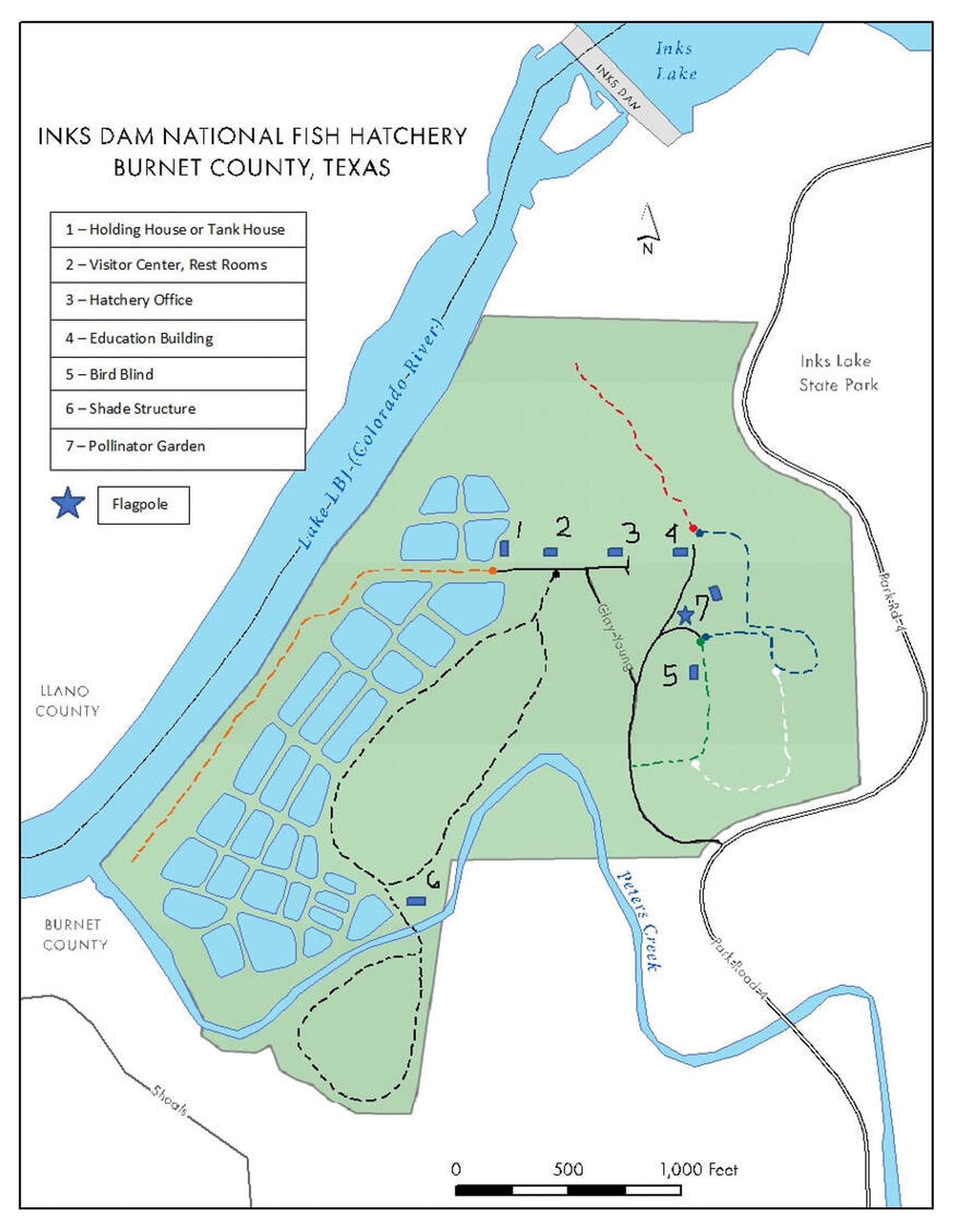Inks Dam National Fish Hatchery

Inks Dam National Fish Hatchery
Burnet, Texas 78611
Official WebsiteInks Dam National Fish Hatchery map
Inks Dam NFH Friends website
Tips for Birding
When you first come through the gate, there are two choices: left to the fish rearing ponds and Colorado River or right to the Pollinator and Native Plant gardens, the bird blind and several hiking trails.
If this is your first visit to the hatchery, it might be a good idea to head to the "Visitor Center" which has a few signs including one with a map, a small cubicle with some information displays and nice restrooms.
From there walk along the river on the paved road. As you start to leave the Visitor Center, you will come to the Fish Holding House. You can stay on the lower level, by the raceway and on the paved road, to follow the River Trail. When the road hits the river and turns left, be sure to look and listen in the thick tangle of vegetation on your right. A fruiting Mulberry Bush has just recently been found in that thick tangle close to the end where things are cleared and you can start to see the river.
In summer time be sure to check the trees across the river for the nesting Red-shouldered Hawks.
As you continue down the River Trail, lots of small passerine birds can be found in the tangles on both sides of the road.
When you get to the fishing dock, be sure to check out all the small rocks in the river. Look for the year round resident (injured) American White Pelican and the pair of Canada Geese who usually nest on top of a rock in the river in the summer. Spotted Sandpipers are usually seen at the water's edge on the rocks in the river.
Continue on the way you came which will bring you back up to the tops of the levees around the fish rearing ponds. If it's winter and waterfowl season, walk all around the ponds. There are usually some dry ponds at this end. Check those dry "cells' for sparrows.
Belted Kingfishers are regular around the ponds as are Great Blue Heron, Great Egret and, in the winter, winter waterfowl and ducks.
From the far southeast corner of the hatchery grounds, you can walk and bird around the Butler Building or cross over the low creek area into the big Pecan Woods.
When you are finished birding around the Butler Building and the woods on the south side of the creek, walk along the fence line back north from the Butler Building towards the Visitor Center. Black-throated Sparrows can usually be found here.
After returning to the Visitor Center, drive over to the bird blind. You might want to visit the restroom facilities here before you leave. These are the only public facilities on the hatchery grounds.
Heading back towards the gate in your car, make the hard left turn at the first "Y" inside the gate. After that, turn right just before the flag pole to park near the bird blind. Walk and bird the pollinator garden. there are two levels in the pollinator garden and a very small water feature (designed for--what else--pollinators but it draws in birds, too) on the upper level just right of the covered kiosk.
After birding at the pollinator garden, walk over to the bird blind. Sit quietly for a bit and more birds will come in. Lincoln's, wrens and other small guys like the brush pile on the left hand side. Warblers come in to the water feature. The hummingbird feeders are maintained by volunteers so check them in the summer for hummers.
Walk the Meadow and Ashe Juniper trails.
The ponds are the most productive part of the hatchery in the winter.
The woodlands along the river, fence line and on Meadow and Ashe Juniper Trail are more productive than the ponds in the summer.
Birds of Interest
Black-capped Vireo has been seen along the Meadow Trail for the past two years. A Long-tailed Duck visited for three months in the winter of 2014. A one-day-wonder Black Skimmer was seen in July 2020. Red-shouldered Hawks have nested in the tall trees on the other side of the river for many years. Great Horned Owls used to nest in the first huge pecan tree after coming down the hill on the River Trail. Blue-gray Gnatcatchers and Verdin breed along the Meadow and Ashe Juniper trails. Ash-throated Flycatchers can usually be seen in the summer on the power lines by the Pollinator Garden. Golden-fronted Woodpeckers also breed on the hatchery grounds and Yellow-billed Cuckoos are summer residents. Look for Black-throated Sparrows along the fence line between the Butler Building and the Visitor Center/Information Kiosk.
About this Location
The hatchery is open from 7 a.m. to 3:30 p.m. seven days a week. During those hours, you may see staff around the hatchery. (If the government is shut down, the hatchery will also be closed)
About the U.S. Fish and Wildlife Service
Since 1871, the National Fish Hatchery system has been at work improving recreational fishing and restoring aquatic species that are in decline, at risk, and are important to the health of our aquatic systems. Across the country, the network of National Fish Hatcheries works with states and Tribes to conserve, restore, and enhance the fish and aquatic resources of America for future generations.
Inks Dam National Fish Hatchery has raised sportfish for distribution throughout the American Southwest since its establishment in 1938. Although the mission has changed numerous times since our beginning, the dedication of past and current staff to producing quality sportsfish that benefit the American public has not. Over the years, the hatchery has added additional roles including acting as the only refuge for the federally listed Clear Creek gambusia and, beginning in 2017, researching cultural production methods for six central Texas freshwater mussels.
U.S. Fish and Wildlife Service Mission
Since 1871, National Fish Hatcheries have been applying science-based approaches to conservation challenges. We work with our partners and engage the public to conserve, restore, and enhance fish and other aquatic resources for the continuing benefit of the American people. Conservation is at the heart of what we do, and we recognize that we do this work for the American people–both the present generation who benefit today and future generations who will inherit our legacy of conserving America’s aquatic resources.
Inks Dam National Fish Hatchery produces channel catfish for Tribal Trust commitments throughout Arizona, New Mexico, Oklahoma, and Texas. The station also acts as a refuge for the federally endangered Clear Creek Gambusia. Additionally, the facility is culturing 6 species of native central Texas freshwater mussels.
History of Inks Dam National Fish Hatchery
Inks Dam National Fish Hatchery was founded in 1938 after Texas Congressman Lyndon B. Johnson arranged an agreement between the Lower Colorado River Authority, the U.S. Bureau of Fisheries (forerunner of the U.S. Fish and Wildlife Service), and the National Youth Administration to construct a hatchery along the Colorado River. The hatchery was operational by 1940.
The original mission of the hatchery was to supply fish for the chain of lakes created by the dams along the Colorado River; however, in the 1950s the emphasis of the agency began to shift toward the farm pond program. The 1980s saw another change when recreational stockings on federal lands, primarily Native American waters in the Southwest, became the priority. This Tribal trust work continues to this day.
Notable Trails
There are lots of places to walk at the hatchery. One can walk along the River Trail which is the paved road to the fishing pier. Be aware of and watch out for cars that are allowed to drive down to the pier and kayak launch. One can walk around all the fish-rearing cells (the ponds where the fish are grown). There is a grove of pecan trees south of the Butler Building which is a nice place to wander. From the Butler Building, one can walk back north towards the parking area at the Visitor Center/Information Kiosk along the fence line. Walk or drive up to the parking areas either behind the Education Building or by the Pollinator Garden by the historic, restored flag pole. From either of these two spots, there are four more trails to walk.
Features
Restrooms on site
Wheelchair accessible trail
Roadside viewing
Entrance fee
Content from Official Website
Last updated January 22, 2024
